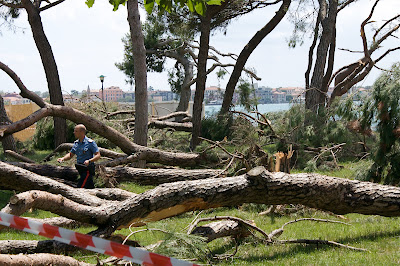 |
| A scene from last year's Festa de San Piero de Casteo: a link to this year's full schedule is at bottom |
That photo would have captured a particularly Venetian response to the Italian National Soccer Team's stirring victory against the heavily favored Germany team in last night's European Cup semi-final.
Actually, it's a response I've seen before, on my first ever visit to Venice as a teenager 30 years ago. Almost exactly three decades ago (11 July), the Italian national team soundly defeated Germany in the 1982 World Cup Final and young Venetians took to the bridges--then off the bridges--to celebrate.
Thanks to a classic American education short on both geography and history, one of the only things I clearly knew about Venice back then--and which I'd learned only upon arrival--was that its foul-smelling canals in the swelter of summer were the very last places I'd ever want to find myself swimming.
Yet much to my amazement--and disgust--Venetians were leaping from the Rialto without a second thought. I remember one especially unfortunate gondolier and his terrified passengers who happened to find themselves very much in the wrong place at the wrong time: with human cannonballs exploding in the water all around them.
I wasn't anywhere near the Rialto last night, but in Sant' Elena after Mario Balotelli's marvelous first goal a group of at least a dozen teenage boys leapt from their chairs in front of the large screen tv outside the Bar Vincent and tore in a riotous mass across the small dark soccer field of the Parco delle Rimembranze to the short bridge connecting the island to the rest of Castello. There, they stripped to their underwear and, in a variety of idiosyncratic manners inspired by ecstasy (dives, cannonballs, even somersults), leapt into the canal.
They did this again after Balotelli's fantastic second goal.
And again, as you can imagine, in a slightly less hurried but no less ecstatic way--and with singing this time!--after the game's conclusion.
Somehow it didn't seem quite so repulsive to me to leap off the Sant' Elena bridge into the fairly broad deep canal of San Pietro di Castello as it did to me 30 years ago to leap from the Rialto into the even broader and deeper Grand Canal in the center of the city. Located at the eastern edge of the city, and just a short distance from where the San Pietro canal opens out to the wide lagoon, the water beneath the Sant' Elena bridge seems much fresher--relatively speaking--than that of the Grand Canal beneath the Rialto.
But don't get me wrong, I wasn't one of the divers.
If I can manage to be a better reporter on Sunday night, I'll have my camera with me for the Final against Spain. But I may be too much of a fan to bother with that.
Just not enough of a fan to throw myself into the canals.
Also going on right now is the Festa de San Piero de Casteo (or of San Pietro di Castello, in Italian). A complete schedule events may be found here: http://www.sanpierodecasteo.org/
 |
| photo credit: Federico Roiter |
You can find more pictures of last year's performance here:
http://veneziablog.blogspot.it/2011/07/festa-di-san-pietro-di-castello.html


























